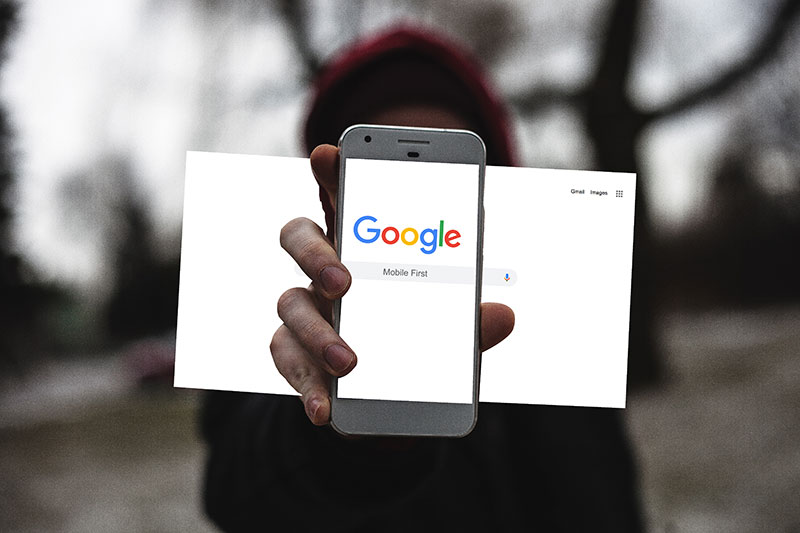Mobile first indexing is happening whether your website is ready or not.
About a year ago, Google announced they were beginning to implement mobile-first indexing after years of preparation. As of December 2018, mobile-first indexing governs more than half of all search results.
In the near future, all websites will be affected by mobile-first indexing. Many websites have already seen their Google rankings rise – or fall.
What is Mobile-First Indexing?
When someone does an internet search, the websites that pop up as the best answers to the search question are generated from an index.
How is the index created? All websites are constantly being scanned by Google for many factors and indexed.
Myth: Google is creating a new, separate index for mobile devices.
Fact: Google has only one index for generating search results. They used to prioritize the desktop version of a site. Now they are prioritizing the mobile version in their index.
The Difference Between Mobile-Friendly and Mobile-First Indexing
Mobile-friendly and mobile-first indexing aren’t exactly the same thing.
Mobile-first indexing is a process that will affect all websites whether they’re mobile-friendly or not.
Mobile-friendly refers to a website that functions well on the small screen of a smartphone or other mobile device. You definitely want a mobile-friendly website as mobile-friendliness is a ranking factor and good for business.
Google provides a quick, free tool to check whether or not a webpage is mobile-friendly.
Responsive Site Design is Great for Mobile-First Indexing
Responsive site design is recommended because it adjusts what the user sees according to screen size, providing the best user experience (UX). If your site already uses responsive web design, you’ve taken a huge step in the right direction.
However, responsive sites can be slow-loading unless properly optimized. Load speed is a significant ranking factor. You can check page speed with Google’s PageSpeed Insights tool.
Optimizing for Speed is Important
Google recommends a mobile load speed of under one second. Few websites achieve this, but it’s critical to be as fast as possible.
The bounce rate will be more than double (106%) for a page load speed of six seconds vs. a page load speed of one second.
That means half of all the people who clicked on your link left to click on your competitor’s site before your page loaded if your site is too slow.
To begin optimizing for load speed you can:
- Use font sizes of 14 or larger
- Avoid large blocks of text; use short paragraphs
- Avoid crowded pages by leaving plenty of white space
Mobile Search is Dominant, Voice Search is Trending Up
Half to three-quarters of all searches are now done with mobile devices. Some niches are affected more than others. Between 70-80% of food and beverage searches (restaurants, shopping etc.) are mobile. About half of travel-related searches are mobile.
Voice searches are becoming increasingly more important. They’re essential in a car and convenient at home and elsewhere. If you haven’t started optimizing for voice search, you need to begin now. By 2020, half of all searches will be voice searches.
Optimizing for voice search includes:
- Content that reflects how people speak: “Find a Mexican restaurant near me.”
- Questions in your content: “Who sells X?”
- Making sure your local listing is optimized.
You’re losing a lot of business if your site isn’t properly optimized.
Mobile-First Indexing and Your Google Ranking
Google says that mobile-first indexing won’t affect your search rankings. As a practical matter, that’s not how it’s worked for a lot of website owners who are already losing leads and conversions.
A mobile-friendly site is a ranking factor. If your site isn’t mobile-friendly, but you had an excellent desktop site, you probably had high rankings. For a while, that won’t change, but the lack of mobile-friendliness will impact your rankings and your bottom line. This will probably happen sooner rather than later.
If your great content doesn’t display well on a smartphone, you’re already losing business. Mobile users have very short attention spans and don’t want to fiddle with a complex navigation system or text that’s hard to read.
Mobile-friendly sites are designed for “fat fingered” smartphone users. Today, that includes just about everyone.
One thing the marketing team at BXP Creative has learned repeatedly over the years is the importance of adaptability. The internet changes people’s expectations and actions. Today’s consumers are the most savvy the world has ever seen.
Your website and marketing strategy has to adapt. What worked well for you previously may not be working as well as it once did.
Optimizing for mobile users and mobile-first indexing will ultimately bring in more traffic and leads. You’ll be providing a great user experience to visitors and that’s always good for your bottom line.
Is your site ready for mobile-free indexing? Want to learn more about how mobile-first indexing can actually benefit your business?
Let’s connect and talk about how we can help.




